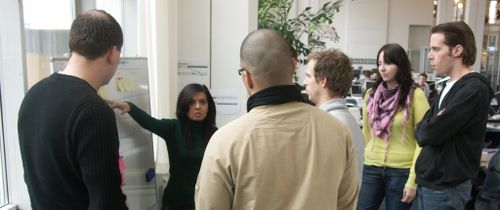People don’t bother with understanding. Really, they don’t. When I tweet something like “Maybe it’s…
To See Is to Follow
Today I started following Ashton Kutcher on Twitter. I didn't really think about this decision for long. It's just that Ashton is the first person in the world to have 1,000,000 followers on Twitter. So, except for the looks, there must be something interesting about this guy, right? I don't know what it is yet, but I'll just go with the flow, and I'm sure I will find out.
Ashton Kutcher is visible. Stories about his race with CNN have been all over the place. For someone reading social networking blogs, it was very hard not to see this. That's why I followed Ashton Kutcher.
So, how do you make people follow good practices?
Easy. Make them visible!
In our organization we are fortunate to have an open office space. Last year we introduced big visible charts in the form of task boards for every development team. Anybody walking around the office can easily see them. So, when other (non-software development) teams noticed these task boards, they wanted them as well! They saw and they followed.
This principle doesn't just work for big visible charts. Any visible process is an information radiator.
We do our stand-up meetings in our open office space as well. We first considered doing stand-ups in a more secluded area, so as not to disturb our colleagues while discussing our projects. But we decided against that. (Our people simply try to argue at a caring and considerate volume.) Then it turned out that, again, other (non-software development) teams started following the same practice. They saw the development teams doing stand-ups every morning, and they decided to try this interesting practice too.
To see is to follow.
People copy each other's behaviors, often for no other reason than just seeing them. It's a human thing. It's why I started following Ashton Kutcher. It's why teenagers start smoking. It's why people have more trust in other people when their own behaviors are being copied. Scientists say humans often mimic each other unintentionally. And they also confirm that "mimicry has a tremendous potential to be used as a tool for influencing interpersonal persuasion and communication."
You can use mimicry to your advantage by making sure that good behavior is visible. If you want people to write better code, then plaster the best code you have all over your coffee machine. If you want other people to follow Scrum practices, then post times and locations for sprint planning and review meetings on your company's public calendars. If you want people to use proper source control and branching techniques, then draw the source control tree and its branches on your office walls.
People follow what they see. You must show what is good, and hide what is bad.
And don't post examples of bad behavior in your office. People might (unintentionally) follow them!
Note: By amazing coincidence, while I was writing this blog post, my music player selected Follow Me (by DJ Lange) from my music library. It is one of the most amazing classic trance tracks I have in my collection. So, please follow me, and listen to Follow Me as a great start for a nice and sunny weekend.
(picture by ^riza^)
 Twitter –
Twitter –  Subscribe –
Subscribe –  Newsletter –
Newsletter –  Bookmarks
Bookmarks
Latest, greatest and favoritest posts:
Islands in the Stream
Great Managers Have No Secrets
Embrace Diversity, Erase Uniformity




